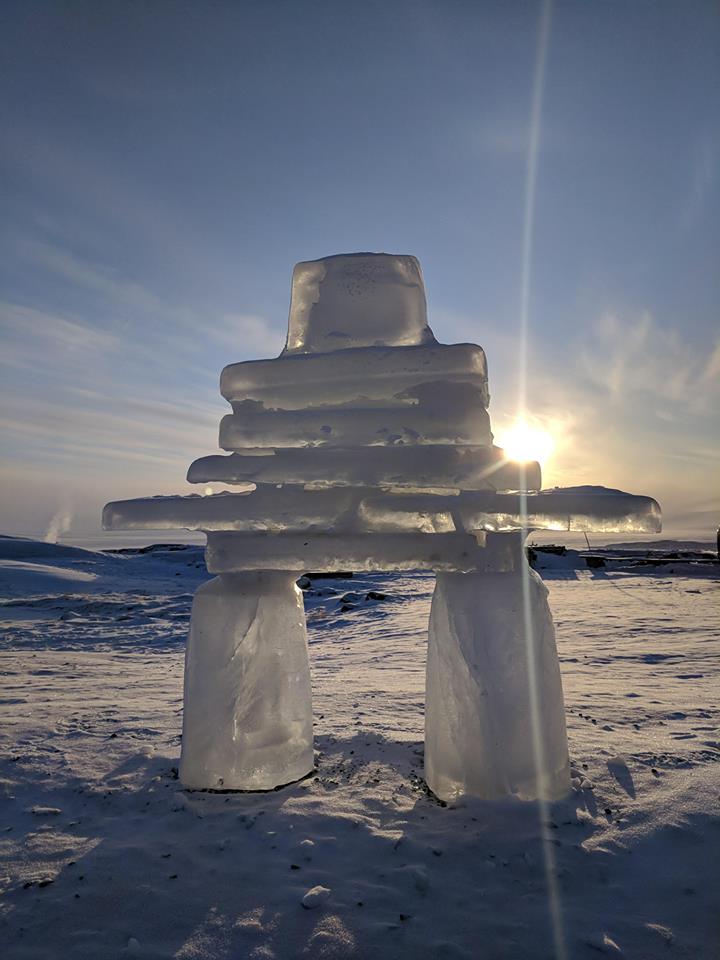Churchill Sunday Photo – Arctic Angel

Iqaluit angel. Photo by Paul Nuyalia.
We can’t get enough of this effect from hot water being thrown into the frigid Arctic air. This “angel” image by Paul Nuyalia is one of the best yet! Enjoy!

Iqaluit angel. Photo by Paul Nuyalia.
We can’t get enough of this effect from hot water being thrown into the frigid Arctic air. This “angel” image by Paul Nuyalia is one of the best yet! Enjoy!

Rankin Inlet in a deep freeze of -60C a couple of days ago. Susan Enuaraq photo.
Rankin Inlet, Nunavut gets cold in the winter. Located on the northwestern shore of the Hudson Bay at 62 degrees and between Chesterfield Inlet and Arviat, the town is definitely in a remote yet exposed region. Weather is just a part of life and recently the weather has been colder than cold.
Schools in the south get “snow days” though when you get to the 60-degree latitudes school closures are “cold days”…usually accompanied by some snow as well. When temperatures fall to -60C with the windchill or more than just about everyone will stay home and not risk going outside and expose skin. For the past few days, schools have cautiously remained closed.
“I don’t remember the last time we actually closed due to weather. This is a bit of an extreme,” said Mike Osmond, chair of the Rankin Inlet District Education Authority.
Temperatures are getting to –40 C before the windchill and when the winds are factored in, it feels colder than –60 C.
“You’ve got blustery winds with some of the coldest temperatures that people have ever experienced,” said David Phillips, senior climatologist with Environment Canada, adding that his charts say skin freezes in two minutes at –55 C.
Windchill was expected to reach above -65C in the past couple of days and we are watching the area closely to see how the community fairs with the dangerous cold. Blame for the almost 15 degrees colder than normal temperatures is being placed on the polar vortex, a combination of an aggressive weather system and frigid air temperatures.
Elders in the Arviat and Rankin region are advising native hunters to remain home until the chill breaks. Living on the land in the past didn’t have this luxury as they had to scavenge for food in even the most dangerous conditions. Grocery stores in these communities of nearly 2,500 people now allow for a community to survive the winter and feel secure in the far north. These towns in the remote northern region do pay high prices for this luxury but there is no other way to survive as a flourishing community.
However, now that people can go to the grocery store, they don’t have to risk their lives hunting in extreme temperatures. Replacing cultural traditions, however, can sometimes be hard for natives to the region used to living off the land and some have gotten themselves into risky situations.
December through February is the coldest time of the year in Rankin Inlet and the urge to get outdoors is always there. However, for many just relaxing inside until the treacherous temperatures rise is sometimes a matter of life or death!
Natural Habitat Adventures guide Brad Josephs and his group of avid and hearty travelers in Churchill for northern lights had time to learn the art of igloo building in frigid minus 50 C Arctic temperatures. Despite the piercing cold, everyone enjoyed the experience and immersed themselves in an authentic Arctic situation and survivalist technique utilized by hunters and travelers out on the tundra and ice of the far north. This system has saved lives every year in the extreme weather of the Arctic. Hopefully, we will bring you some tantalizing northern lights from this adventure in the next couple of days. Churchill’s aurora borealis season is heating up even during this incredibly cold stretch!
This awe-inspiring video compilation from Alan Dyer in Churchill portrays the essence of experiencing the northern lights in such a remote and beautiful raw location. This season more than ever has literally shed inspirational “light” on the town of Churchill and all the strong people that have endured being isolated even more since the Hudson Bay Rail Line has been washed out. Hopefully, before next aurora season, the train will be back running to Churchill and the northern lights will be shining just as brightly!
This short film, Eye of the Storm is set in Iceland. Storms of all kinds form in Iceland with, sand, ash, snow, rain and solar being the most common. Storms often demonstrate the power of nature and its effects on our planet Earth. Natures mystery is unveiled when we see the landscapes created from They reveal nature’s beauty and its hand in creating the landscapes visible today. This compilation was filmed in Iceland between February and March of 2014 when a phenomenal solar flare and coronal mass ejection collided with Earth’s atmosphere. The northern lights emanating from particles colliding with the atmosphere are just supernatural in appearance. Enjoy!

A beautiful Inukshuk made of ice glistens in the Iqaluit sun. Tracy Wood photo.
This awesome ice inukshuk welcomes travelers to Iqaluit in the Arctic. These iconic northern features mark trails or food caches. They were also used by caribou hunters to herd the animals toward an area for harvest. No feature, other than the stoic polar bear, is more recognizable in the open Arctic tundra then these, usually stone inukshuks. An ice one captures the soft colors and light of the region!